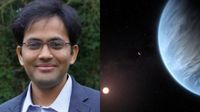In a groundbreaking development in the search for life beyond Earth, scientists have uncovered potential signs of biological activity on the distant exoplanet K2-18b, located over 120 light-years away in the Leo constellation. This significant discovery was led by Indian-origin astrophysicist Dr. Nikku Madhusudhan, a professor at the University of Cambridge, who has dedicated his career to studying exoplanets and their atmospheres.
Using data from NASA’s James Webb Space Telescope (JWST), researchers detected carbon-rich molecules such as methane and carbon dioxide in the exoplanet’s atmosphere. Among the most intriguing findings was the possible trace of dimethyl sulfide (DMS), a molecule that on Earth is produced solely by living organisms, particularly marine phytoplankton. Dr. Madhusudhan stated, “The best explanation for our observations is that K2-18b is covered with a warm ocean, brimming with life.” This discovery marks a pivotal moment in the ongoing quest to find extraterrestrial life.
K2-18b is classified as a sub-Neptune exoplanet, orbiting a red dwarf star known as K2-18, and lies within its habitable zone—the region around a star where conditions might allow for liquid water to exist. This planet is approximately 2.6 times larger and 8.6 times more massive than Earth, leading scientists to hypothesize that it may be a “Hycean” world—a term coined by Dr. Madhusudhan to describe planets with hydrogen-rich atmospheres and potential global oceans.
During a recent press conference, Dr. Madhusudhan emphasized the significance of these findings, stating, “This is the strongest evidence yet that life may exist beyond Earth.” He further noted that while they have not yet confirmed the presence of life, the data collected offers promising leads. He remarked, “I can realistically say that we can confirm this signal within one to two years,” according to the BBC.
The JWST’s advanced instruments, including the Near-Infrared Imager and Slitless Spectrograph (NIRISS) and the Near-Infrared Spectrograph (NIRSpec), played a crucial role in detecting these key molecules. NASA has highlighted that the detection of DMS remains unconfirmed and will require further observations to ascertain its presence at significant levels. “Upcoming Webb observations should be able to confirm if DMS is indeed present in the atmosphere of K2-18b,” NASA stated.
Dr. Madhusudhan's background is as impressive as his current research. Born in India in 1980, he studied engineering at the Indian Institute of Technology (IIT-BHU), Varanasi. He later moved to the United States, where he earned his master’s and doctoral degrees in planetary science from the Massachusetts Institute of Technology (MIT). His career has included research roles at prestigious institutions such as Yale, Princeton, and now Cambridge, where he is recognized for his work on exoplanetary atmospheres and biosignatures.
Notably, Dr. Madhusudhan’s introduction of the concept of Hycean planets has expanded the definition of habitability, suggesting that planets unlike Earth may also support life. He believes that if life is confirmed on K2-18b, it would imply that life is likely common throughout the galaxy. “If we confirm that there is life on K2-18b, it should basically confirm that life is very common in the galaxy,” he stated.
The discovery of K2-18b has reignited interest in the Fermi Paradox, which questions why, given the vast number of planets in the universe, we have yet to encounter signs of intelligent life. While Dr. Madhusudhan’s findings do not provide a definitive answer to this age-old question, they represent a significant step toward understanding our place in the cosmos. Some scientists speculate that life may be widespread but still in primitive forms, while others argue that we may simply be looking in the wrong places.
As research continues, K2-18b will remain a focal point for astronomers using the JWST. Future missions, including the European Space Agency’s Ariel mission scheduled for launch in 2029, are set to further investigate the atmospheres of similar exoplanets. This ongoing exploration promises to enhance our understanding of the potential for life beyond Earth.
In summary, the detection of possible biosignatures on K2-18b not only propels the search for extraterrestrial life but also reminds humanity of the vast mysteries that still lie beyond our solar system. As Dr. Madhusudhan aptly put it, “It is a transformational moment in the search for life beyond the solar system.” With continued advancements in technology and research, the dream of discovering life beyond our planet may be closer than ever.





